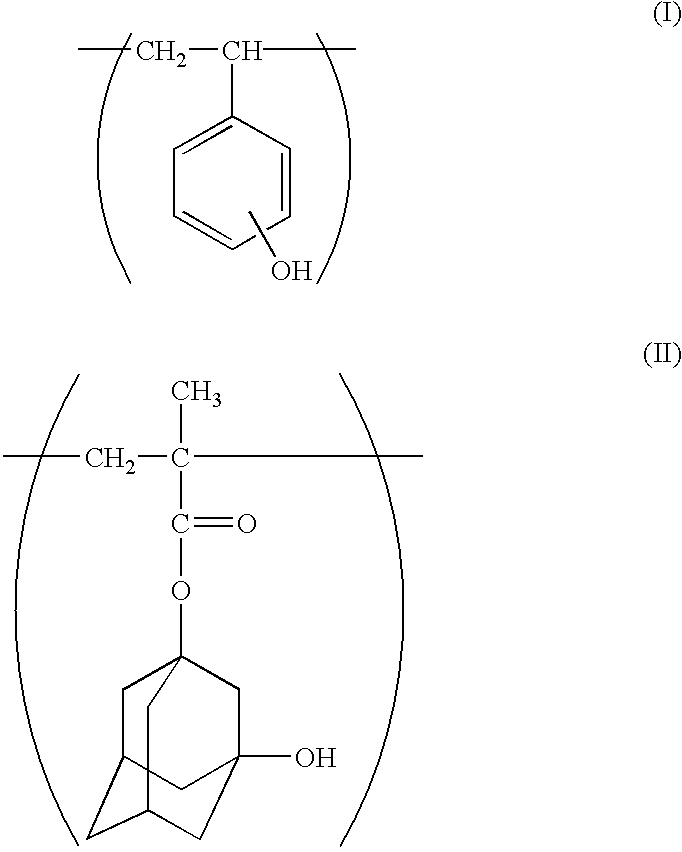Chemical amplification type positive resist composition
a technology of amplification type and composition, applied in the direction of photosensitive materials, photomechanical equipment, instruments, etc., can solve the problems of conventionally known resist compositions with limits in resolution, sensitivity, exposure capacity, etc., and achieve the effects of improving resolution and exposure latitude, sensitivity, heat resistance, and resolution
- Summary
- Abstract
- Description
- Claims
- Application Information
AI Technical Summary
Benefits of technology
Problems solved by technology
Method used
Image
Examples
synthesis example 1
Production of a Partially 1-ethoxyethylated hydroxystyrene / 3-hydroxy-1-adamantyl Methacrylate Copolymer
(1) Production of tert-butoxystyrene / 3-hydroxy-1-adamantyl methacrylate copolymer
120 g (0.68 mol) of 4-tert-butoxystyrene, 16.74 g (0.08 mol) of 3-hydroxy-1-adamantyl methacrylate, and 273.49 g of 2-propanol were charged to a 500 ml four-neck flask and heated up to 75.degree. C. in an atmosphere of nitrogen. Separately, a solution in which 10.45 g of dimethyl 2,2'-azobis(2-methylpropionate) was dissolved in 27.35 g of 2-propanol, was prepared and added to the above-described monomer solution kept at 75.degree. C. dropwise over 30 minutes. The resulting mixture was kept stirred for 23 hours, further heated, and refluxed for 8 hours. After cooled down to room temperatures, the reaction mixture was added to a mixture constituted of 2,688.2 g of methanol and 1,344.1 g of ion exchange water while stirring the latter. The reaction mixture was kept stirred for 3 hours and then filtrated t...
synthesis example 2
Production of Another Partially 1-ethoxyethylated hydroxystyrene / 3-hydroxy-1-adamantyl Methacrylate Copolymer
Except that the quantity of the solution constituted of propylene glycol monomethyl ether acetate and the copolymer of 4-hydroxystyrene and 3-hydroxy-1-adamantyl methacrylate dissolved therein after distillation under reduced pressure was adjusted so as to be 178.63 g, and that the amount of charge of ethyl vinyl ether was 4.27 g (0.06 mol), the procedure of (3) of Synthesis Example 1 was repeated. The solid concentration of the resin solution thus obtained was 21.5%, and the analysis of this resin by .sup.1 H-NMR revealed that the percentage of the number of 1-ethoxyethoxy groups relative to the number of benzene rings was 15.0%. This resin will be referred to as Resin B.
synthesis example 3
Production of Partially 1-ethoxyethylated Polyhydroxystyrene
40 g (333 mmol on p-hydroxystyrene unit basis) poly(p-hydroxystyrene) (tradename "VP-15000") manufactured by Nippon Soda Co., Ltd. and 47 mg (0.25 mmol) of p-toluenesulfonic monohydrate were charged to a 1 liter eggplant-shape flask and dissolved in 720 g of propylene glycol monomethyl ether acetate. This solution was distilled under reduced pressure under conditions of a temperature of 60.degree. C. and a pressure of not higher than 10 Torr for azeotropic dehydration. The quantity of the solution after distillation was 337 g. This solution was transferred to a 500 ml four-neck flask which had been nitrogen gas-exchanged. 12.0 g (166 mmol) of ethyl vinyl ether was added thereto dropwise, and the resulting solution was reacted at 25.degree. C. for 5 hours. To this reaction solution were added 62.3 g of propylene glycol monomethyl ether acetate and 320 g of methyl isobutyl ketone, and 240 ml of ion exchange water was further ...
PUM
| Property | Measurement | Unit |
|---|---|---|
| degree of polydispersity | aaaaa | aaaaa |
| molar ratio | aaaaa | aaaaa |
| molar ratio | aaaaa | aaaaa |
Abstract
Description
Claims
Application Information
 Login to View More
Login to View More - R&D
- Intellectual Property
- Life Sciences
- Materials
- Tech Scout
- Unparalleled Data Quality
- Higher Quality Content
- 60% Fewer Hallucinations
Browse by: Latest US Patents, China's latest patents, Technical Efficacy Thesaurus, Application Domain, Technology Topic, Popular Technical Reports.
© 2025 PatSnap. All rights reserved.Legal|Privacy policy|Modern Slavery Act Transparency Statement|Sitemap|About US| Contact US: help@patsnap.com



